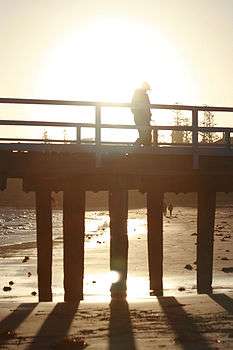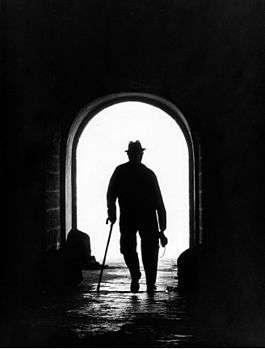Contre-jour
"Contre jour" redirects here. For the video game, see Contre Jour.

Contre-jour photo taken directly against the setting sun causing loss of subject detail and colour, and emphasis of shapes and lines. Medium: Colour digital image.

Contre-jour emphasizes the outline of the man and the tunnel entrance. The ground reflections show the position of the man. Medium: Digital scan from B&W paper print.
Contre-jour (French for "against daylight") is a photographic technique in which the camera is pointing directly toward a source of light.
Contre-jour produces backlighting of the subject. This effect usually hides details, causes a stronger contrast between light and dark, creates silhouettes and emphasizes lines and shapes. The sun, or other light source, is often seen as either a bright spot or as a strong glare behind the subject.[1] Fill light may be used to illuminate the side of the subject facing toward the camera. Silhouetting occurs when there is a lighting ratio of 16:1 or more; at lower ratios such as 8:1 the result is instead called low-key lighting.
See also
| Wikimedia Commons has media related to Contre-jour photography. |
| Look up contre-jour in Wiktionary, the free dictionary. |
References
- ↑ Freeman, Michael (2007) The Complete Guide to Light & Lighting in Digital Photography. ILEX, London: Lark Books. pp. 74&75. ISBN 978-1-57990-885-0.
This article is issued from Wikipedia - version of the 4/4/2015. The text is available under the Creative Commons Attribution/Share Alike but additional terms may apply for the media files.